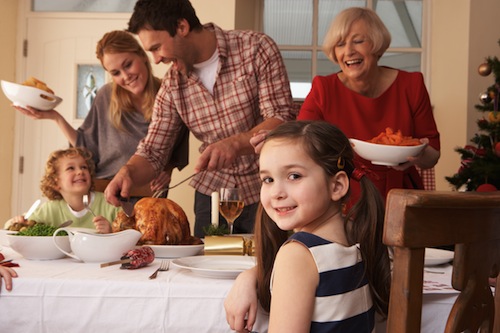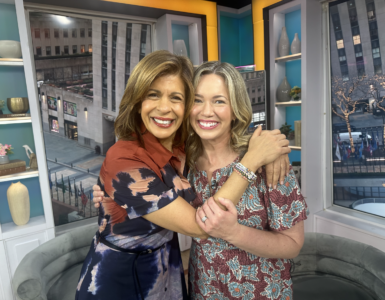If it’s your turn to host Thanksgiving dinner, don’t do all the work yourself.
Delegate!
A trio of Studio 5 Contributors shows you how to pull off the perfect potluck
from start to finish. Janine Ottley tackles the etiquette of asking people to
bring things. Consumer educator, Teresa Hunsaker, on keeping it hot and
serving a crowd and food stylist, Suzy Eaton, on taming the mish-mash of
dishes for a pretty presentation.
Planning Etiquette
Plan- Use the websites to make sure your guests aren’t bringing all main
dishes or too many pies. It’s alright if two people bring green salads,
chances are you’ll need them and they won’t be exactly the same.
Potluck Websites:
Prepare- You never know when one of your well-intentioned guests might
have made less than they should have, so in a pinch, always be prepared with
easy dishes that you can microwave, toss together, or bake quickly to make
sure you always have enough food. The sin at any party is to run out of food
before you run out of guests.
Promptly start- You want to make sure that you’re not still blow drying your
hair at 6pm if that’s when your party begins. If your guests have planned on
arriving at a specified time, your hair, your house, and the table…as well as
everything else, needs to be ready to the best of your ability in order to make
others feel comfortable while they are there. Of course things don’t always
go perfectly, but with a little preparation and forethought, you can pull of a
successful Potluck and enjoy your time with friends and family without
having to stress about all the extras.
Food Preparation and Food Safety
The last thing any of us want to get or give this holiday season, or anytime
for that matter, is a case of food poisoning. As we get ready to serve food
for any group or gathering the very first thing that should be on our mind is
how to not only prepare the food safely, but how to serve it safely.
I know how easy it is to get caught up in the decorations, theme, and invites,
but let’s not forget to be up to date on our preparation and serving skills too.
Preparation Reminders
When you are preparing food for large groups it is especially wise to keep the
following 4 things in mind:
Clean: Wash hands well before preparing the foods. Have surfaces
clean
(and sanitized where necessary), and use clean equipment and food
preparation tools. Wash cutting boards, dishes, utensils, and counter tops
with hot, soapy water after preparing each food item and before you go on to
the next item. A solution of 1 tablespoon of unscented, liquid chlorine bleach
in 1 gallon of water may be used to sanitize washed surfaces and utensils.
Cook: Be sure the foods you are preparing are cooked to the
proper
temperatures. Here is a temperature chart for meats:
ü 140°F = Ham fully cooked
ü 145°F = Steaks and Roasts, Fish
ü 160°F = Pork, Ground Beef, and Egg Dishes
ü 165°F = Chicken Parts or Whole Poultry, Stuffing, Casseroles, and
Uncooked Ham
Separate: Separate raw meat, poultry, and seafood from other
foods in your
grocery-shopping cart and in your refrigerator. Place raw meat, poultry, and
seafood in containers in the refrigerator, to prevent their juices from dripping
on other foods. Raw juices may contain harmful bacteria. When cutting
boards are used:
ü Always use a clean cutting board.
ü Use one cutting board for fresh produce and a separate one for raw
meat, poultry, and seafood.
Chill: Refrigerate or freeze perishables, prepared foods, and
leftovers within
2 hours (1 hour when the temperature is above 90 °F) of shopping or
preparing. Never defrost food at room temperature. Thaw food:
ü In the refrigerator.
ü In the microwave, but cook the food immediately.
Food may also be thawed in cold water. Be sure that the sink or container
that holds food is clean before submerging food. Two methods may be used
when thawing in cold water:
1. Completely submerge airtight wrapped package. Change water every
30 minutes. OR,
2. Completely submerge airtight wrapped food in constantly running cold
water. Cook food immediately after thawing.
Transporting Reminders
Getting your hot or cold food from point A to point B may be a challenge.
Think through the logistics of who has been invited to bring what and how
they are going to get it to the appointed location.
· You can insulate hot foods by wrapping them well in newspaper or
slipping them into a brown paper bag, then wrapping the bag with a heavy
blanket. It is surprising how long the food will stay hot. Note: Depending
on the distance to be traveled and serving time, you may just want to take
your “hot” dish uncooked/cold and heat or cook on site.
· Large blocks of ice will keep food colder and last longer than cubes. Take
a large container that you are going to discard anyway (like a plastic gallon
milk container, small plastic water bottles, etc.). Rinse the container out real
well and fill it about two inches from the top with water. Freeze it until you
are ready to pack your cooler and go.
Serving Reminders
Bacteria multiply rapidly between 40 and 140 °F. To keep food out of this
“Danger Zone,” keep cold food cold and hot food hot.
· Keep food cold in the refrigerator, in coolers, or on the serving line on
ice. Frozen gel packs can also serve as a way to keep food cold on a serving
line…place them under a lightweight napkin on a serving tray with the food
dish on top of that.
· Keep hot food in the oven, in heated chafing dishes, or in preheated
steam tables, warming trays and/or slow cookers…which means having
sufficient outlets and electrical access. Sometimes multiple heating units will
trip the electrical box.
· Be sure you have enough oven, stovetop, refrigerator, freezer, and work
space.
References:
USDA’s “Cooking For Groups” publication; Food Safety and Inspection Service
www.fsis.usda.gov
Government Food Safety Information www.foodsafety.gov
Food and Drug Administration www.cfsan.fda.gov
Centers for Disease Control and Prevention www.cdc.gov/foodsafety
Partnership for Food Safety Education (Fight BAC!®) www.fightbac.org
If you have any questions, contact Teresa Hunsaker at the Family and
Consumer Science Education Department at the Weber County USU Extension
office at (801) 399-8203 or online at extension.usu.edu/weber/
# # #
Presentation:
Tips to make your next potluck look pulled together:
#1 Camouflage
Disguise mis-matched serving pieces with fall leaves, pumpkins and other
décor items you have on hand. Hollow out a pumpkin and hide a crock pot
inside, turn a small hollowed out squash into a candy dish.
#2 Re-plate
Have plates, platters and bowls on hand to put the food on that others bring
to keep the theme of the table décor.















Add comment